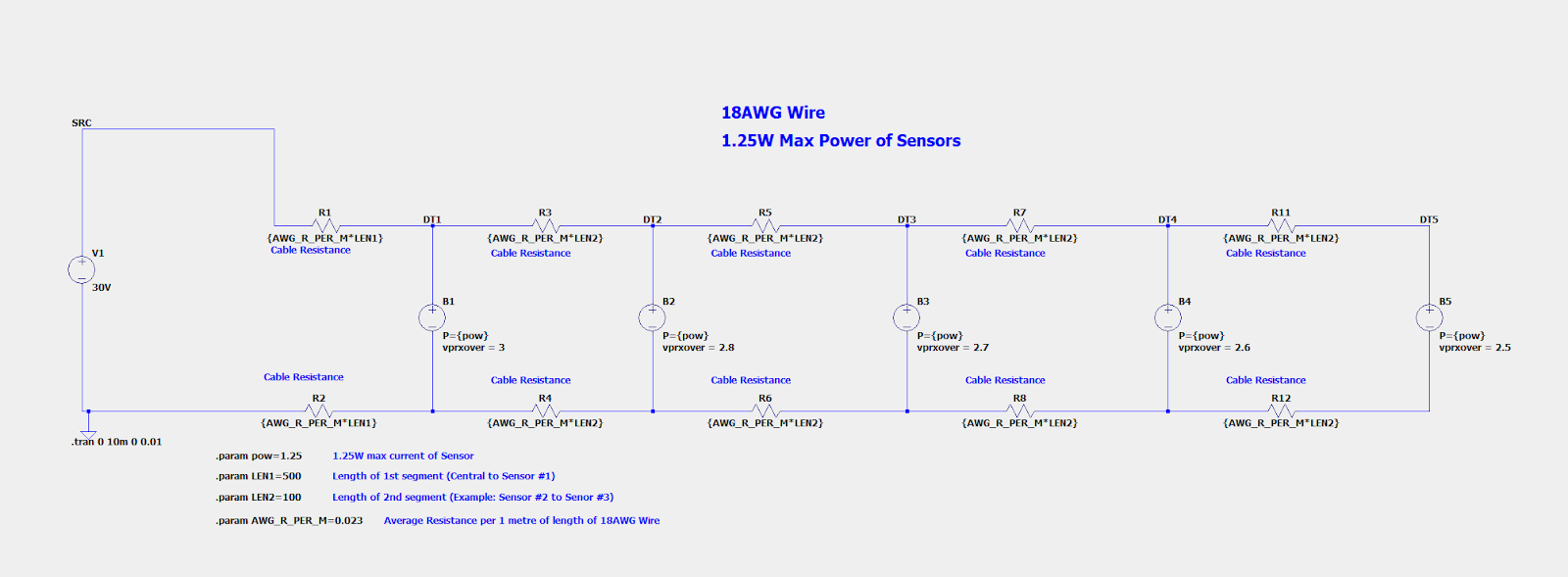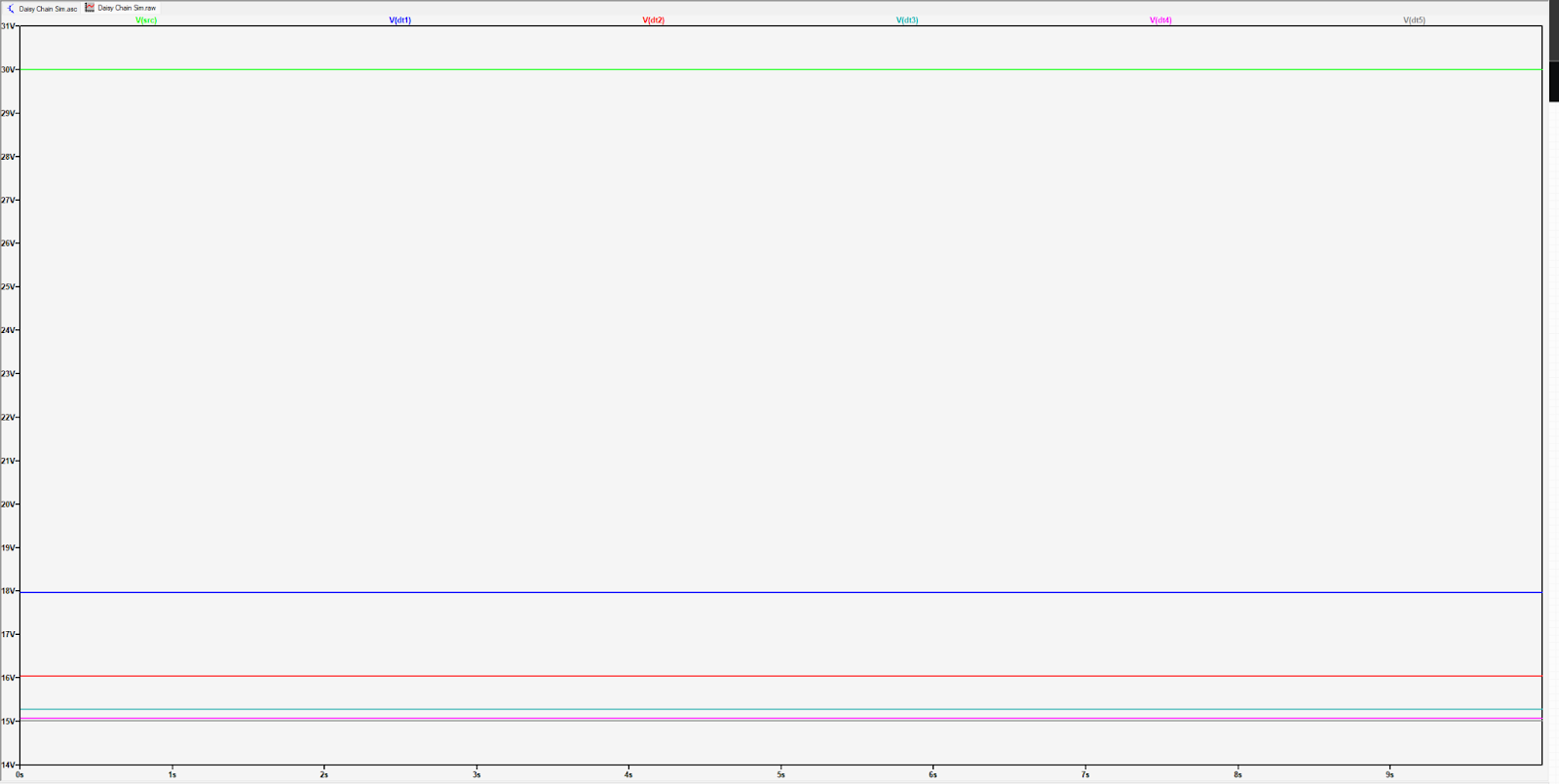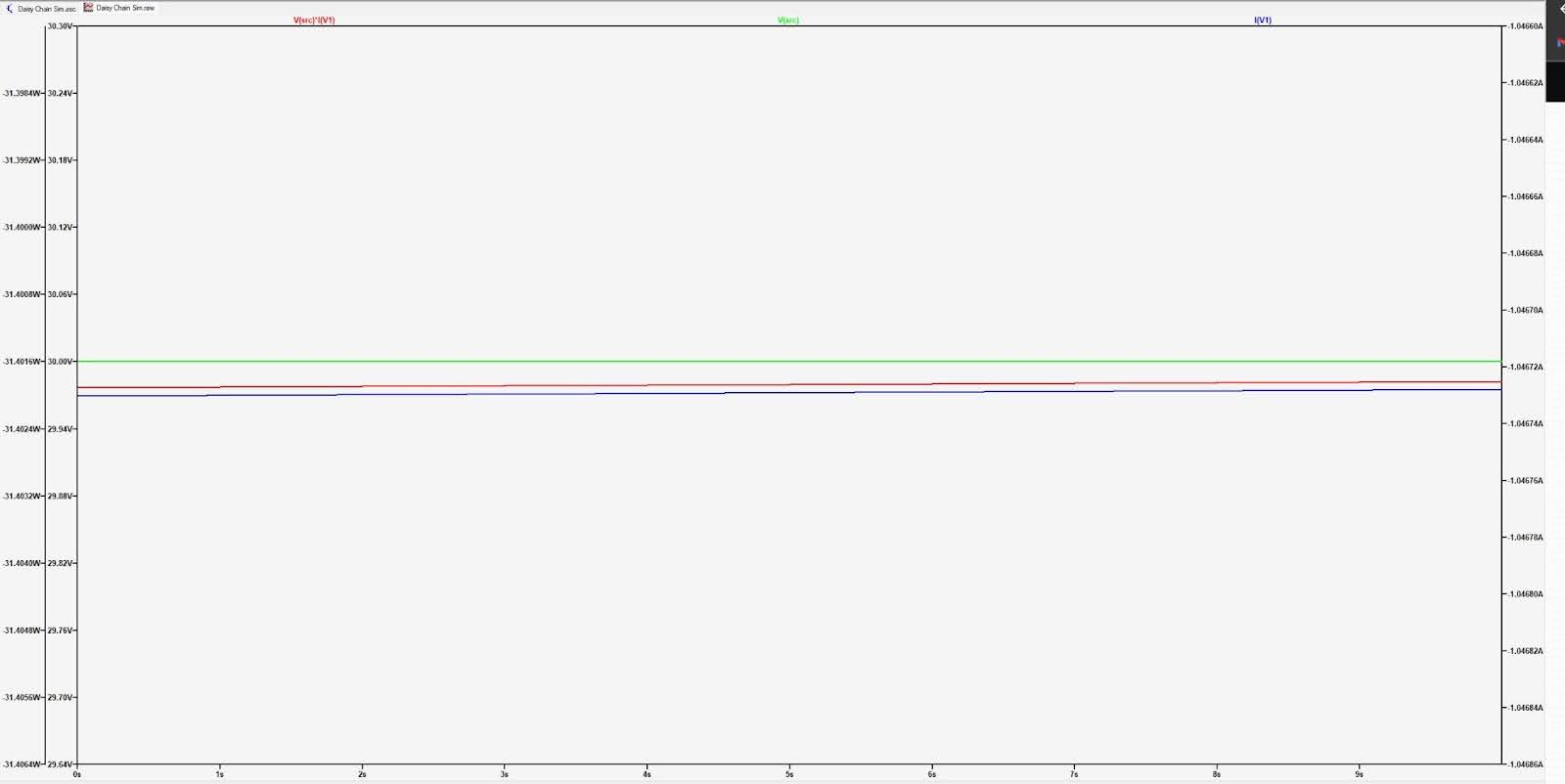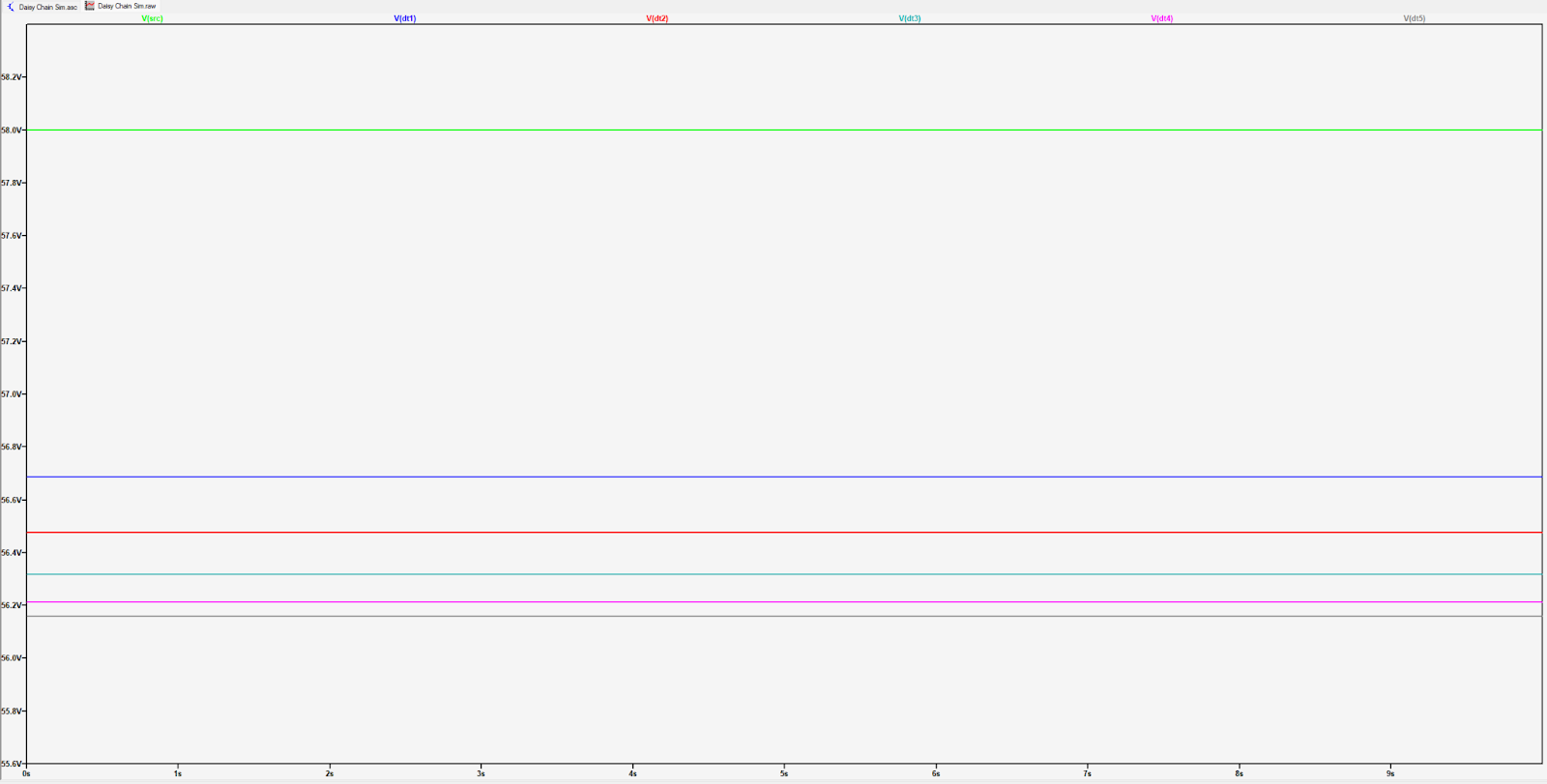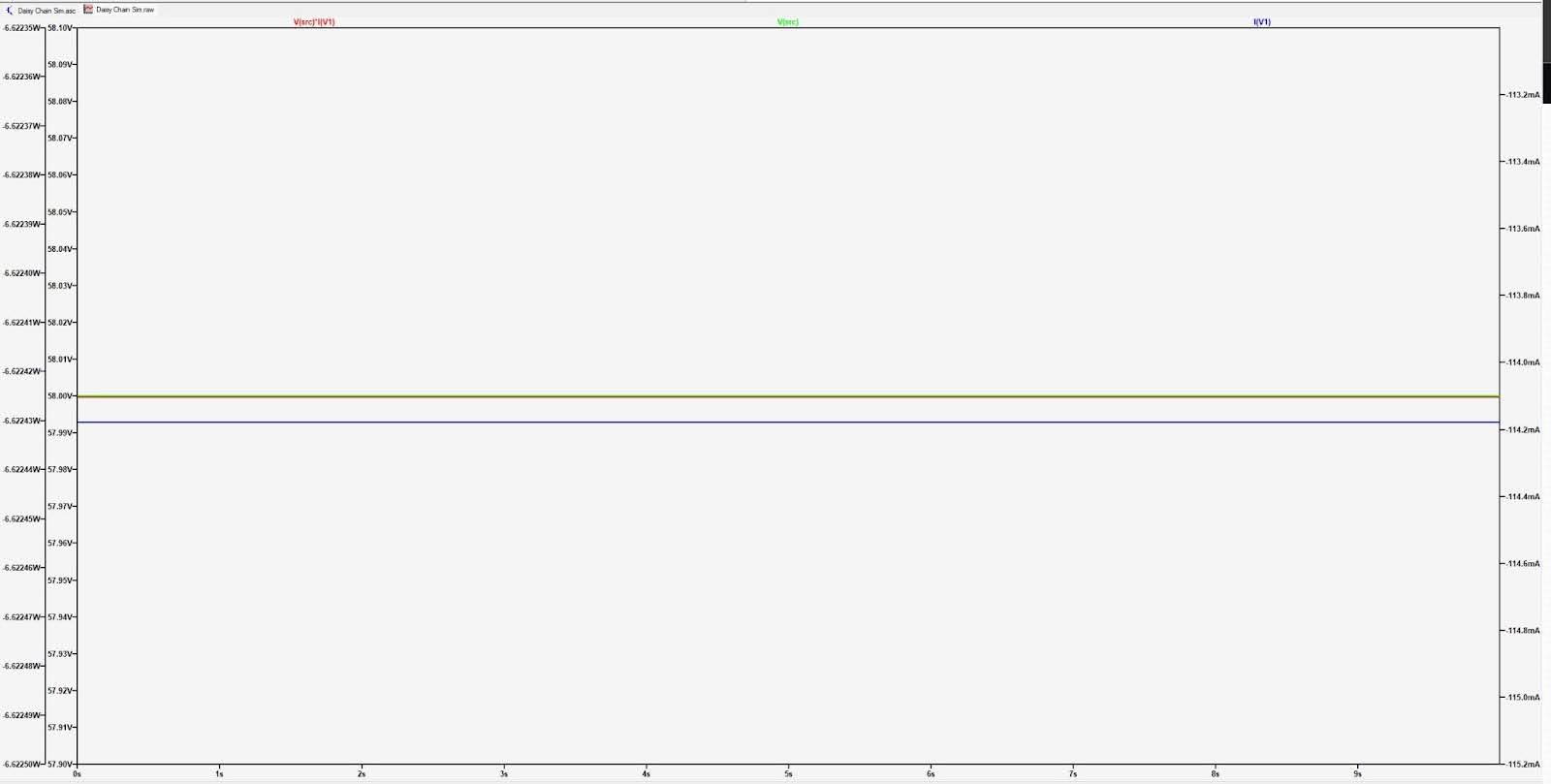
WHITE PAPER
Designing Daisy Chained Sensor Networks
WRITTEN BY MARK MCALLISTER, SENIOR TECHNICAL LEAD AT MISTYWEST
1. Abstract
Designing daisy-chained sensor networks involves careful planning to ensure efficient and reliable performance. This white paper provides a practical guide for engineers and designers, covering essential aspects such as selecting transceivers, physical interfaces, communication protocols, power solutions, and cable configurations. Our aim is to equip professionals with the knowledge needed to develop robust sensor networks for various applications.
Fill out the form to read our white paper.
2. Introduction
Sensor networks are used across industries, from automation to environmental monitoring. Daisy-chained configurations can simplify wiring and reduce costs, but they require careful design to ensure reliability.
This white paper provides guidance on designing daisy-chained sensor networks. We cover key elements like selecting the right transceivers and physical interfaces, and we evaluate different communication protocols to determine the best fit. We also examine power solutions and the importance of cable configurations, including considerations for rugged environments.
With practical advice and an example design process, this guide aims to provide you with the tools needed to create reliable and efficient sensor networks.
3. Design Considerations
Designing a daisy-chained sensor network involves key decisions around network topology, data rate, cable length, and environmental factors. This section breaks down these vital elements to help engineers optimize network performance while balancing cost and installation ease.
3.1. Network Topology
When designing daisy-chained sensor networks, the network topology can determine the system’s efficiency, reliability, and ease of maintenance. The two primary topologies for daisy-chained networks are linear and ring topologies.
3.1.1. Linear Topology
In a linear topology, sensors are connected in a sequential manner, with each sensor connected to the next in line. The data flows from one end of the chain to the other, passing through each sensor along the way.
Advantages:
-
Simplicity: Linear topologies are straightforward to design and implement, making them suitable for small to medium-sized networks.
-
Cost-Effective: Fewer cables and connectors are required compared to more complex topologies, reducing overall costs.
Disadvantages:
-
Single Point of Failure: If one sensor or connection fails, the entire network beyond that point is affected, potentially causing significant downtime. Multi-drop solutions can deal with the risk of a sensor failure, but are still vulnerable to the risk of single point connection failure.
-
Scalability: Adding more sensors to a linear network can be challenging, especially if the initial design did not account for future expansions.
3.1.2. Ring Topology
In a ring topology, sensors are connected in a circular manner, with the last sensor linked back to the first, forming a closed loop. Data travels in one or both directions around the ring until it reaches its destination.
Advantages:
-
Redundancy: Ring topologies offer built-in redundancy. If one connection fails, data can still travel in the opposite direction to reach its destination, enhancing network reliability.
-
Improved Fault Tolerance: The network can continue to function even if a segment is disrupted, reducing the impact of individual failures.
Disadvantages:
-
Complexity: Designing and maintaining a ring topology is more complex than a linear topology, requiring more sophisticated network management.
-
Cost: More cables and connectors are needed to complete the loop, increasing the initial setup costs.
3.1.3. Choosing the Right Topology
Selecting the right topology depends on the application, the number of sensors, and the operating environment. A linear topology may suffice for smaller, less critical networks, but larger or more demanding applications benefit from a linear topology with a failsafe secondary connection or a ring topology for enhanced reliability.
Hybrid approaches can also be effective, combining different topologies to balance cost, complexity, and reliability. For example, using a linear topology within sensor subgroups, then connecting these subgroups in a ring, can boost network resilience.
Carefully evaluating these factors allows designers to choose the most effective topology, ensuring the network meets performance and reliability requirements.
3.2. Data Rate and Bandwidth
Understanding data rate and bandwidth requirements for your daisy-chained sensor networks allows you to determine the network’s capacity to handle data from multiple sensors.
3.2.1. Determining Data Rate Requirements
Data rate depends on sensor output, sampling frequency, number of sensors, and data packet size. Higher sampling frequencies and more sensors increase the data load, while packet size, including protocol overhead, impacts the overall rate.
3.2.2. Bandwidth Considerations for Different Applications
Bandwidth is the network’s capacity to carry data. Different applications have different bandwidth considerations: Industrial automation requires high bandwidth for real-time, low-latency data. Environmental monitoring needs reliable long-distance transmission. Healthcare demands continuous, fault-tolerant streams, while smart buildings balance moderate data rates with system integration.
3.2.3. Optimizing Data Rate and Bandwidth
To optimize data rate and bandwidth in a daisy-chained network:
-
Choose Efficient Protocols: Opt for protocols with minimal overhead like RS-485 and CANbus.
-
Use Data Compression: Compress data to reduce transmission size without losing quality.
-
Segment and Aggregate: Break the network into smaller sub-networks, then aggregate data to ease the load on any single path.
-
Prioritize Important Data: Ensure important data is transmitted first to reduce latency.
By optimizing these factors, designers can ensure efficient, reliable operation tailored to their specific needs.
3.3. Cable Length and Requirements
Cable length impacts a daisy-chained sensor network’s performance in a number of ways, affecting signal integrity, power delivery, and cost. Practical challenges like installation complexity, weight, and cost make cable selection a critical decision. This section addresses key factors to consider during cable selection.
3.3.1. Maximum Cable Length
The maximum cable length for any point to point connection is determined by the type of communication standard used and the capabilities of the transceivers. For example: RS-485 can support longer cable runs, often up to several hundred meters, while others like Ethernet may have stricter length limitations without repeaters or switches. It’s essential to adhere to the protocol’s specifications to maintain signal integrity and prevent data loss.
3.3.2. Signal Integrity
Maintaining signal integrity over long distances is fundamental to ensuring reliable communication. Key factors that affect signal quality include cable resistance, capacitance, and susceptibility to electromagnetic interference (EMI). To preserve signal integrity:
-
Use twisted-pair cables to reduce EMI.
-
Employ shielding to protect against external interference.
-
Ensure proper termination at the end of the cable run to prevent signal reflections.
3.3.3. Environmental Requirements
The physical environment where the cables will be installed plays a significant role in cable selection. Factors to consider include:
-
Temperature Range: Cables must withstand the operating temperature range without degrading.
-
Moisture and Corrosion Resistance: In environments prone to moisture or chemicals, cables should have appropriate protective jackets.
-
Rugged Environments: For installations in harsh conditions, cables need to be tough and durable, with high tensile strength and resistance to abrasion.
3.3.4. Cost Implications
Cable costs are driven by factors such as the type and length of the cable, the number and type of conductors, and any protective measures needed for the installation environment. Copper cables are typically less expensive but may require thicker gauges for longer runs to minimize resistance. In contrast, fiber optic cables, while more expensive, offer superior signal integrity over long distances and are immune to EMI, making them ideal for specific, high-performance applications. To keep costs down, it’s advantageous to design with mass-produced cables that are widely used in other industries, leveraging economies of scale rather than relying on costly custom solutions.
4. Cable Selection and Configuration
The cables used in a daisy-chained sensor network will impact its performance, reliability, and cost-efficiency. This section explores the different types of cables. their key properties, and the environmental factors that need to be considered during cable selection.
4.1. Cable Types
The two primary types of cables used in sensor networks are copper cables and fiber optic cables.
4.1.1. Cable Types – Copper Cables
Copper cables are widely used in sensor networks for their affordability and ease of installation. They come in several forms:
-
Single-Conductor: These simple cables consist of a single copper wire and are typically used for power transmission or low-speed data in basic applications.
-
Twisted Pair: Common in RS-485 and Ethernet applications, twisted pair cables are effective at reducing EMI and are ideal for moderate distances.
-
Coaxial: Coaxial cables offer better shielding and lower EMI, making them suitable for high-EMI environments such as Ethernet over Coax.
Advantages:
-
Cost-effective and easy to install.
-
Versatile for various applications.
-
Simple and inexpensive for basic power distribution with single-conductor cables.
Disadvantages:
- Limited by distance and signal attenuation.
-
Susceptible to interference in high-EMI settings, especially with single-conductor cables.
-
Coaxial cables are more rigid and harder to install.
-
Single-conductor cables offer poor EMI performance and limited data transmission capabilities.
4.1.2. Cable Types – Fiber Optic Cables
Fiber optic cables are the go-to choice for applications requiring high data rates and long-distance transmission, such as in data centers or undersea internet cabling. They transmit data as light signals, ensuring exceptional signal integrity and complete immunity to electromagnetic interference (EMI).
Advantages:
-
High Bandwidth: Capable of supporting very high data rates, making them ideal for demanding applications.
-
Long-Distance Transmission: Minimal signal loss over long distances, far exceeding the capabilities of copper cables.
-
EMI Immunity: Completely immune to electromagnetic interference, ensuring reliable performance even in high-EMI environments.
Disadvantages:
- Higher Cost: More expensive than copper cables, both in material costs and installation.
-
Installation Challenges: More difficult to install and terminate, requiring specialized equipment and trained personnel.
-
Fragility: More sensitive to physical damage, requiring careful handling and protection during installation.
4.2. Environmental Requirements
Cables in sensor networks must withstand various environmental conditions to ensure long-term reliability and performance. Key environmental considerations include:
4.2.1. Temperature Resistance
Cables must function within the temperature range of their installation environment. High temperatures can degrade insulation, while low temperatures can cause brittleness, impacting performance and longevity.
4.2.2. Moisture and Corrosion Resistance
In environments exposed to moisture, chemicals, or corrosive substances, cables require protective jackets to prevent degradation. Common materials like PVC, polyethylene, and Teflon offer excellent resistance to moisture and chemicals.
4.2.3. Rugged Environments
For industrial or outdoor installations, cables need to be tough and durable. Important features include:
-
High Tensile Strength: To resist mechanical stresses.
-
Abrasion Resistance: To prevent damage from wear and tear.
-
UV Resistance: To withstand prolonged exposure to sunlight in outdoor settings.
5. Physical Interface and Protocols
This section highlights some of the key physical interfaces and associated protocols that can be used in daisy-chained networks. It will discuss the strengths and trade-offs of the available options and help you choose what best fits your project’s needs.
5.1. Twisted Pairs
Twisted pair cables are a popular choice in sensor networks due to their balance of performance, cost, and EMI resistance. Below are the key protocols that leverage twisted pair cabling for effective communication in daisy-chained networks.
5.1.1. RS-485 (Modbus, Profibus)
RS-485 is a widely used protocol in industrial settings, known for its robustness and ability to handle long-distance communication and multi-drop buses. It’s particularly effective in environments with high electromagnetic interference (EMI).
Advantages:
- Long Distance: Supports cable lengths up to 1200 meters, making it ideal for large installations.
-
Noise Resistance: Reliable in noisy industrial environments due to its differential signaling.
-
Scalability: Can connect up to 32 devices on a single bus.
Disadvantages:
- Termination Requirements: Requires precise termination to prevent signal reflections.
-
Lower Data Rates: Offers slower data transmission compared to Ethernet, limiting its use in high-speed applications.
RS-485 Protocols:
- Modbus: A simple, widely adopted protocol for basic industrial automation tasks.
-
Profibus: More complex, offering higher data rates and additional features suitable for advanced industrial processes.
5.1.2. CANbus
CANbus is primarily used in automotive and industrial control systems. It excels in environments where real-time communication and error handling are essential.
Advantages:
- Error Handling: Excellent at detecting and correcting errors, ensuring data integrity.
- Real-Time Communication: Supports time-sensitive data transmission, ideal for control systems.
- Scalability: Can support up to 128 devices on a single network.
Disadvantages:
- Data Rate: Limited to a maximum of 1 Mbps, which may not meet the needs of data-intensive applications.
- Complexity: More challenging to implement compared to simpler protocols like Modbus.
5.1.3. Standard Ethernet
Ethernet is a widely recognized standard, offering high data rates and flexibility, making it suitable for applications requiring substantial data transfer.
Advantages:
- High Data Rates: Capable of speeds up to 10 Gbps, supporting data-heavy tasks.
- Infrastructure: Leverages a broad range of existing tools and infrastructure.
- Versatility: Supports various topologies, adaptable to different network designs.
Disadvantages:
- Distance Limitations: Typically limited to 100 meters without repeaters, making it less ideal for very large installations.
- Cost and Complexity: Generally more expensive and complex to implement compared to RS-485 or CANbus.
5.1.4. Single Pair Ethernet (10/100/1000 Mbps)
Single Pair Ethernet (SPE) is an emerging technology that enables Ethernet communication over a single twisted pair of wires, making it an ideal choice for applications where space, weight, and cost are critical. SPE is particularly beneficial in industrial automation, automotive systems, and building automation, offering flexible solutions for various data rates and distances. SPE comes in 4 distinct varieties:
10BASE-T1S
-
Range: Up to 25 meters.
-
Bandwidth: 10 Mbps.
-
Topology: Supports point-to-point and multi-drop topologies.
-
Use Case: Ideal for short-range, low-bandwidth applications in industrial automation and building automation.
-
Target Industries: Manufacturing, smart buildings, and process control.
10BASE-T1L
-
Range: Up to 1 km (extendable with certain PHYs).
-
Bandwidth: 10 Mbps.
-
Topology: Designed for point-to-point connections.
- Use Case: Perfect for long-distance communication in industrial and building automation, where extended reach is necessary.
-
Target Industries: Industrial automation, building infrastructure, and utilities.
100BASE-T1
-
Range: Up to 50 meters.
-
Bandwidth: 100 Mbps.
-
Topology: Designed for point-to-point connections.
-
Use Case: Suitable for higher data rate applications in automotive and industrial networks, where reliable short-range connectivity is needed.
-
Target Industries: Automotive, industrial automation, and robotics.
1000BASE-T1
-
Range: Up to 15 meters.
-
Bandwidth: 1000 Mbps (1 Gbps).
-
Topology: Designed for point-to-point connections.
-
Use Case: Best for high-speed data transmission in compact environments, such as within automotive systems or other space-constrained applications.
-
Target Industries: Automotive, aerospace, and high-performance computing systems.
5.2. Coaxial
Ethernet communication can occur over coaxial cables through the use of frequency multiplexing, which allows Ethernet signals to be transmitted efficiently over a single coaxial line.
Advantages:
-
Extended Range: Coaxial cables can support Ethernet transmissions over longer distances compared to standard Ethernet over twisted pair cables. They can often exceed the typical 100-meter limit of twisted pair Ethernet without needing repeaters, making them suitable for applications that require longer cable runs.
-
Effective EMI Shielding: Coaxial cables provide excellent protection against electromagnetic interference ensuring stable and reliable signal transmission.
-
Cheaper Than Fiber: Coaxial cables are generally less expensive than fiber optic cables, making them a cost-effective solution when extended range and EMI protection are needed, but the highest data rates of fiber are not required.
Disadvantages:
-
Limited Bandwidth: Although coaxial cables offer benefits like extended range and EMI protection, they generally provide lower data rates compared to modern Ethernet standards, which may limit their use in high-bandwidth applications.
-
Signal Attenuation: Despite their extended range, coaxial cables still experience attenuation over long distances, which may require the use of amplifiers or repeaters to maintain signal strength in very long runs.
5.3. Fiber
Ethernet over Fiber is the gold standard for high-speed, long-distance data transmission, making it the go-to solution for applications requiring ultra-high bandwidth and immunity to electromagnetic interference (EMI). Fiber optic cables transmit data as light signals, providing exceptional signal integrity over vast distances.
Advantages:
-
High Bandwidth: Fiber optic cables support extremely high data rates, making them ideal for data-intensive applications where large amounts of information need to be transmitted quickly and efficiently.
-
Long-Distance Transmission: Fiber optics can transmit data over much greater distances than copper or coaxial cables with minimal signal loss, eliminating the need for frequent repeaters.
-
EMI Immunity: Because fiber optic cables use light to transmit data, they are completely immune to electromagnetic interference, ensuring reliable performance in environments where EMI could disrupt other types of cabling.
Disadvantages:
-
Higher Cost: Fiber optic cables are generally more expensive than copper or coaxial alternatives, both in terms of materials and the specialized equipment required for installation.
-
Installation Complexity: Installing fiber optic cables requires specialized knowledge and equipment, making it more challenging and costly to deploy compared to other cabling options.
-
Fragility: Fiber optic cables are more delicate and susceptible to physical damage than copper cables, requiring careful handling and protection during installation and use.
6. Power Solutions
This section examines both standalone power connections and combined data and power options, providing a clear understanding of their benefits and trade-offs to help you select the most effective approach for your application.
6.1. Standalone Power Connection
Standalone power connections involve using separate cables for power and data transmission. This approach provides flexibility but can increase complexity and cost.
Advantages:
-
Flexibility: Allows for independent optimization of power and data cables.
-
Reduced Interference: Separate power lines can help minimize electromagnetic interference (EMI) affecting data transmission.
-
Scalability: Easier to scale as power needs increase without impacting data lines.
Disadvantages:
-
Increased Cost: Requires additional cabling and connectors, increasing material and installation costs.
-
Complexity: More complex installation and maintenance due to separate power infrastructure.
6.2. Combined Data and Power
Combining data and power into a single cable can simplify installation and potentially reduce cabling costs. Several technologies enable this integration, each suited to different applications and requirements.
6.2.1. Power Line Communication (PLC)
Power Line Communication (PLC) is a technology that allows data transmission over power lines, making it a convenient option when you want to combine power and data without running separate cables. There are a number of different PLC standards that could be used including HomePlug AV/AV2, IEEE 1901 etc. Modules such as the WisLink PLC LX200V30 can be used to create a PLC solution
Advantages:
-
Simplified Cabling: By using the same lines for both power and data, PLC reduces the need for additional cabling, simplifying installation in environments where space is limited.
-
Cost-Effective Installation: Since PLC can run both power and data over the same connection, it can lower the costs associated with deploying separate data cables, making it a more economical solution in many cases.
Disadvantages:
-
Limited Data Rate and Distance: PLC typically supports lower data rates and shorter transmission distances than dedicated data cables, which might limit its effectiveness in high-bandwidth or long-distance applications.
-
Susceptibility to Noise: Electrical noise and interference from other devices on the power line can degrade data quality, making PLC less reliable in environments with significant electrical noise.
6.2.2. Power over Coax (PoC)
Power over Coax (PoC) allows both power and data to be transmitted over a single coaxial cable, making it an efficient solution in applications where coaxial cabling is preferred or required. This method is particularly beneficial in environments with high electromagnetic interference (EMI), where coaxial cables’ strong shielding provides reliable performance.
6.2.3. Power over Ethernet (PoE)
Power over Ethernet (PoE) is a widely adopted technology that delivers both power and data over standard Ethernet cables. This integration simplifies installation and is ideal for a variety of applications, including networking devices like IP cameras, wireless access points, and sensors.
Advantages:
-
Simplified Installation: Combines power and data into a single cable, reducing the complexity and cost of installation.
-
Standardized and Versatile: Supported by established IEEE standards (802.3af/at/bt), ensuring broad compatibility across a wide range of devices and equipment.
-
Flexible Deployment: Suitable for various environments, from offices to industrial settings, where Ethernet cabling is already in place or preferred.
Disadvantages:
-
Distance Limitations: Typically limited to 100 meters without the use of repeaters, which may be a constraint in larger installations.
-
Power Constraints: Power delivery is limited by the PoE standard used, with a maximum of up to 100W (PoE++), which may not be sufficient for devices with higher power demands.
6.2.4. Power over Data Line (PoDL)
Power over Data Line (PoDL) is a technology that delivers both power and data over a single pair of conductors, specifically designed for Single Pair Ethernet (SPE) networks. PoDL is ideal for applications where space and weight are limited, such as in industrial automation and automotive systems. However, PoDL has defined power classes that limit the power available to devices, which impacts the supported load and the maximum cable length for that load.
PoDL is best suited for powering low-power devices like sensors and communication modules over distances that SPE can support, typically up to 1 km for lower power classes. This makes it a practical choice for environments where power demands are moderate, and cabling needs to be minimized.
Advantages:
-
Streamlined Cabling: Reduces the amount of cabling needed by integrating power and data into a single pair of conductors, making it ideal for space-constrained environments.
-
Optimized for SPE: Specifically designed for use with Single Pair Ethernet, making it a natural choice for modern, compact Ethernet applications in industries like automotive and industrial automation.
-
Emerging Standard: As an emerging technology, PoDL is gaining traction, offering a forward-looking solution for next-generation network deployments.
Disadvantages:
-
Limited Power Delivery: The defined power classes for PoDL impose limitations on the amount of power that can be delivered to PDs, as well as the number of supported supply voltages. These limitations may restrict their use in applications with higher power demands.
-
Technology Maturity: As emerging technologies, PoDL have yet to achieve the widespread adoption and support that more established solutions like traditional PoE enjoy, potentially limiting their compatibility and availability.
-
Specific SPE Types: The effectiveness of PoDL is closely tied to the type of SPE in use, with certain SPE configurations offering more limited power delivery capabilities, which may not be sufficient for all applications.
See the full list of power classes for powered devices (PDs) in this application note from Texas Instruments.
7. Example Design Process
In this section, we demonstrate the application of the design techniques and considerations that we have discussed by working through the design of a daisy-chained sensor network using an example application in the mining industry.
7.1. Description of a Sample Application
A mining site has three installations of a very large, slow rotating piece of equipment. There is interest in designing a solution to provide predictive maintenance monitoring for this equipment through the use of accelerometers.
Key details of the problem are summarized below.
Installation Requirements:
-
There are three machines on site
-
Each machine has 5 specific points of interest where vibration sensors should be installed for measurement
-
Each set of 5 sensors should be connected together in a daisy chain wired network, where the distance between any two sensors in the chain can be a maximum of 100m
-
Sensor data from each chain must be returned to central terminal for processing and analysis
-
The maximum distance between the central terminal and any of the machines is 500m
-
Cabling weight should be minimized where possible
Sampling Requirements:
-
The machinery of interest is a large, slow rotating piece of equipment, and there is a specific interest in capturing the high-frequency resonances that indicate early-stage bearing faults
-
The highest frequency of interest has been identified as 20KHz
Power:
-
The sensor electronics, without networking components, require 0.02W in standby mode and 0.5W in continuous capture mode
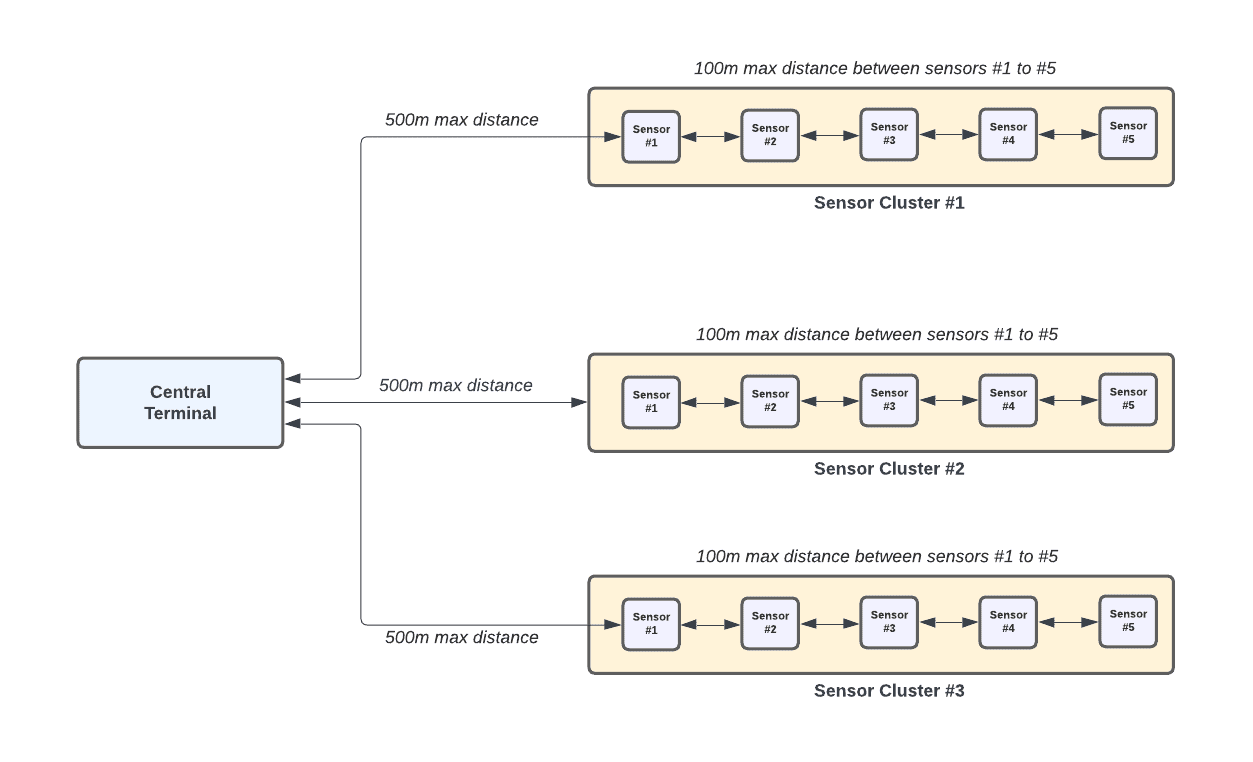
7.2. Length and Data Requirements
7.2.1. Length
In this application we have two separate links to consider:
-
Central to Sensor Cluster: “The maximum distance between the central terminal and any of the machines is 500m”
-
Sensor to Sensor connections: “...where the distance between any two sensors in the chain can be a maximum of 100m”
The length of the Central to Sensor Cluster link reduces the number of available wired communication options:
Not Suitable:
-
RS-485: Although RS-485 can theoretically support distances of up to 1.2km, this is achieved by reducing the data rate. Consequently, Modbus (RTU) and Profibus cannot provide suitable data rates for a 500m link.
-
CAN bus: Can bus cannot support 500m links
-
Wired Ethernet: Can only support links longer than 100m with the use of repeaters which increase the installation complexity and cost
-
10BASE-T1S: The multidrop support of 10BASE-T1S would have been useful for the 5 sensor string, as it reduce the number of sensors that can act as a single source of failure, but unfortunately the 100m distance between them are larger than the 25m supported by 10BASE-T1S.
Suitable:
-
Ethernet over coax or Fiber: Both can support a link of 500m but require expensive specialized converter equipment and expensive cabling materials in the case of fiber.
-
10BASE-T1L Single Pair Ethernet: Provides 10Mbps connectivity up to 1km in length over a single twisted pair and can provide options for date and power provision over the same twisted pair via PoDL (Power over Data Line).
7.2.2. Data
To provide sufficient headroom and better accuracy for the vibration data we will use an ADC with a 100Ksps sampling rate, 5 times the highest frequency of interest of (20Khz) and a resolution of 14 bits.
With each sensor cluster consisting of up to 5 sensors, and 16 bits per sample, that results in a combined data rate of 1.6Mbps for the Central to Sensor Cluster link and 0.32Mbps for each Sensor to Sensor connection.
7.2.3. Proposed Solution
Considering the need for high data rates and long-distance communication, 10BASE-T1L Single Pair Ethernet (SPE) is an ideal choice for this application. It offers a 10 Mbps connection over distances up to 1 kilometer, ensuring reliable data transmission across the entire sensor network. The direct IP addressability of each sensor simplifies software development and integration, making it easier to manage and monitor the network. Additionally, 10BASE-T1L supports the option to combine data and power over the same twisted pair, further simplifying the installation and reducing cabling requirements.
7.3. Power Conductor Requirements
In any daisy chained network with significant cable lengths it is vital to evaluate the power requirements and simulate to understand the impact of cable losses.
Cable losses can cause significant issues that are challenging to understand without simulation or testing due to the non-linear feedback mechanism between voltage drop and increased current requirements:
1. Increased Resistive Losses Lead to Voltage Drop:
-
As current flows through the resistive cables, some of the supply voltage is dropped across the resistance of the wires. The greater the resistance and the higher the current, the more significant this voltage drop becomes.
2. Lower Voltage at Sensors Requires Higher Current:
-
To maintain the power at each sensor, the sensor must draw more current as the voltage drops.
3. Increased Current Exacerbates Resistive Losses:
-
As the current increases to compensate for the lower voltage, the power lost in the cables also increases. This further reduces the voltage available at the sensors, which then requires even more current, and the cycle continues.
To simulate our network and understand the power requirements we will require an estimate for the total power of each sensor, including its networking components.
7.3.1. Estimating Power Requirements
We have already been given the base power requirements of the sensor, excluding any network components:
“The sensor electronics, without networking components, require 0.02W in standby mode and 0.5W in continuous capture mode.”
To calculate an estimate for the total sensor power we must account for the networking components required to support the 10Base-T1L connections.
The selection of 10Base-T1L will require the addition of the following components:
-
2x 10BASE-T1L Transceivers:
-
Single Transceiver Power:~250mW Active, ~190mW Standby
-
Combined Power: ~500mW Active, ~380mW Standby
-
1x Ethernet Switch: ~250mW Active, ~100mW Standby
So our total power requirement for a complete sensor is:
-
Standby Mode: 200mW + 380mW + 100mW = 0.68W
-
Active Mode: 500mW + 500mW + 250mW = 1.25W
Each sensor requires a maximum power of 1.25W in Active mode, so the base load of each 5 sensor cluster is 6.25W.
7.3.2. Power Conductor Requirements
Typically, 18 AWG or 20 AWG twisted-pair cables are used in long-reach applications. These gauges offer a good balance between resistance (which impacts voltage drop and power loss) and flexibility. We will select 18 AWG as our conductor size for our simulations.
7.3.3. Power Simulations in LTSpice
In this simulation we have used resistors to represent the cable losses, where we have parameterized the length and resistance per meter of the gauge of wire selected. Constant power load elements have been used to represent the sensors in the network, with the power set to the 1.25W estimate that we calculated.
We have to select a supply voltage for our system simulation. If we want to provide power and data over the same twisted pair using PoDL then we must use a power class from that standard.
Select one of the power classes for PDs (Powered Devices) and PSEs (Power Supply Equipment), set out in the PoDL standards, that can support 10Base-T1L.
The “IEEE 802.3cg 10BASE-T1L Power over Data Lines Powered Device Design” application note from Texas instruments provides background on PoDL and lists the power classes for PDs (Powered Device) and PSEs (Power Supply Equipment) set out in the standard.
The standard defines 5 different types of PSEs and 15 different power classes for PDs.
As we are using 10BASE-T1L we must use a Type E PSE which can provide 30V or 58V supply voltage and PD power classes 10 to 15.

Class E PSE’s can provide 30V or 58V, so we will simulate those source voltages and evaluate the total power requirements of the daisy chain network.
7.3.3.1. 30V source Simulation
Simulations with a 30V source voltage indicate a significant voltage drop over the first 500 meters, resulting in approximately 18V at the first sensor and 15V at the last sensor in the chain. These voltage drops lead to increased power consumption across the network. The simulation reveals that powering the sensor chain with a base load of 6.25W requires a source power of around 30W, translating to a power transmission efficiency of just 17%.
When comparing this to the PoDL power classes, it’s clear that 30W exceeds the maximum load supported by Class E PSEs operating at 30V (Class 10: 1.23W, Class 11: 3.2W, Class 12: 8.4W). This indicates that using a 30V PSE supply voltage would not meet the required PoDL specifications.
30v source simulation
30v source simulation v2
7.3.3.2. 58V source Simulation
Simulations with a 58V source voltage show a significantly reduced voltage drop over the first 500 meters, resulting in approximately 56.7V at the first sensor and 56.2V at the last sensor in the chain. This leads to a much more efficient power consumption across the network. The simulation indicates that powering the sensor chain with a base load of 6.25W requires a source power of about 6.62W, achieving a power transmission efficiency of 94%.
When compared to the PoDL power classes, a 6.62W load is well within the capabilities of all Class E PSEs operating at 58V (Class 13: 7.7W, Class 14: 20W, Class 15: 52W). This confirms that using a 58V PSE supply voltage allows the daisy chain to be powered over PoDL while meeting all required specifications.
58v source simulation
58v source simulation v2
7.3.3.3. Conclusions
Based on our simulations, we will power the daisy chain using PoDL with a Class 13 PSE at 58V. This class supports a 7.7W load, which exceeds the 6.62W requirement for our sensor chain while ensuring high power transmission efficiency.
Alternatively, if a lower source voltage or smaller wire gauges are preferred, we could opt out of PoDL, allowing for different source voltages but requiring separate cabling for data and power. The same simulation methods can be used to evaluate these non-PoDL options.
Lastly, it’s important to remember that simulations are a tool for assessing design options, but real-world testing is necessary for final verification.
7.4. Cable Specification
Given the simulation results and the requirement to use 18 AWG wire, several cabling configurations can be considered for the daisy-chained sensor network. These configurations must ensure reliable power delivery and data transmission over the required distances while minimizing voltage drops and maintaining signal integrity.
7.4.1. Cable Configuration #1: Separate Data and Power
This configuration uses separate conductors for data and power, offering flexibility in managing power delivery and data transmission.
Example Configuration:
-
4x 18 AWG conductors, with two dedicated to power and a single twisted pair for data transmission.
-
6x 18 AWG conductors are used, with four conductors dedicated to power (two supply and two return) and a single twisted pair for data transmission.
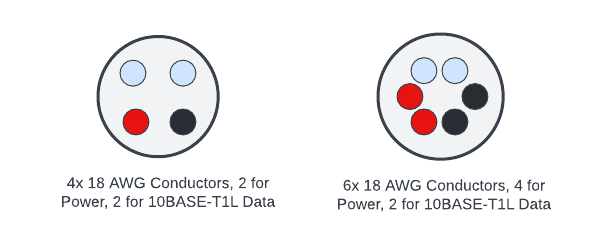
Cable Configuration #1
Power Distribution
Where one conductor is used for the supply, and one for the return, the number of conductors are minimized but will lead to higher voltage drops over long distances when compared to 4 conductors of the same gauge.
Voltage drops can be reduced by decreasing the resistance of the cabling, which can be achieved by using larger gauge wire, or more conductors of the same gauge for supply and return.
Data Requirements
Data is transmitted over a single 18 AWG twisted pair which must maintain a characteristic impedance of 100 ohms ± 15 ohms to support 10BASE-T1L communication.
Shielding
Effective shielding around the data pair helps to minimize electromagnetic interference (EMI) and ensure clean signal transmission.
7.4.2. Cable Configuration #2: Combined Data and Power
This configuration simplifies the cabling by combining data and power transmission on a single twisted pair, using 2x 18 AWG conductors.
Combining power and data on a single 18 AWG twisted pair reduces the overall cabling but requires careful management to avoid interference between power and data signals.
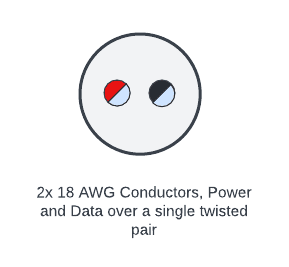
Cable Configuration #2
7.4.3. Conclusion
For most installations, the choice between separate and combined power and data cabling hinges on balancing power delivery, signal integrity, and cabling simplicity. Separate conductors for power and data (Cable Configuration #1) are ideal for longer distances and higher power demands, as they minimize voltage drops and offer greater flexibility in power distribution.
However, for this installation, the requirement to “minimize cabling weight where possible” is a pivotal factor. To reduce cable weight, we will select the combined power and data configuration (Cable Configuration #2). This approach not only simplifies the installation by reducing the number of conductors but also effectively minimizes the overall cable weight, aligning with the project’s requirements.
7.5. Solution
After considering all key elements, we propose a daisy-chained sensor network that meets the project’s requirements.
Networking Components in Sensor
Each sensor will use the 10BASE-T1L standard for communication. To support this, each sensor includes:
-
A low-power Ethernet switch to manage data traffic between sensors and the central terminal.
-
Two 10BASE-T1L transceivers for high-speed data transmission along the chain.
-
Power coupling and decoupling circuitry to support PoDL power delivery.
Cabling
Data and power will be transmitted over a single 18 AWG twisted pair shielded cable, selected for its efficiency in carrying both signals while minimizing cabling complexity and weight. This cable will maintain a 100-ohm characteristic impedance to ensure reliable 10BASE-T1L communication.
Power Supply at Central Terminal
The central terminal’s power supply will adhere to the Type E PoDL PSE standard, capable of supporting a PD Power Class 13 (7.7W load at 58V).
Conclusion
By integrating these components, we achieve an efficient network design that meets the technical requirements for power delivery, high-speed data capture, and installation simplicity. The use of 10BASE-T1L transceivers and a combined power and data cabling approach not only optimizes the network for long-distance, high-frequency vibration monitoring but also addresses the need to reduce cable weight. The carefully selected power supply ensures consistent performance across the entire sensor network, delivering a robust and lightweight solution.
8. Conclusion
Designing daisy-chained sensor networks requires significant planning to balance efficiency, reliability, and cost-effectiveness. This report has provided a practical guide for engineers, covering critical aspects such as communication protocols, transceiver selection, physical interfaces, power solutions, and cable configurations.
The design exercise demonstrated how to apply these principles to a design a network for monitoring vibration data in a demanding industrial environment.
This report equips professionals with the knowledge and tools necessary to design and implement effective daisy-chained sensor networks that are reliable, efficient, and adaptable to various applications.
9. Appendix
9.1. References and Additional Reading
9.1.1. Single Pair Ethernet
- Excel: White Paper – Single Pair Ethernet (SPE)
- Texas Instruments: “IEEE 802.3cg 10BASE-T1L Power over Data Lines Powered Device Design”
- Analog Devices: “Designing a Deployable 10BASE-T1L Single-Pair Ethernet Condition Monitoring Vibration Sensor”
- Texas Instruments: Application Note: How to Implement an IEEE 802.3cg or 802.3bu-Compliant PoDL PSE
- Texas Instruments: Reference Design – Daisy-chained power and data over single pair Ethernet (T1)
- Texas Instruments: Reference Design – 10BASE-T1L SPE Sensor With Power Over Data Lines (PoDL)
- TDK: Single Pair Ethernet: How to implement 10Base-T1L
- Microchip: Application Note – AN1848 Using Power over Data Line functionality in 10BASE-T1S System
- Texas Instruments: White Paper – Leveraging Single-Pair Ethernet in Building Automation
